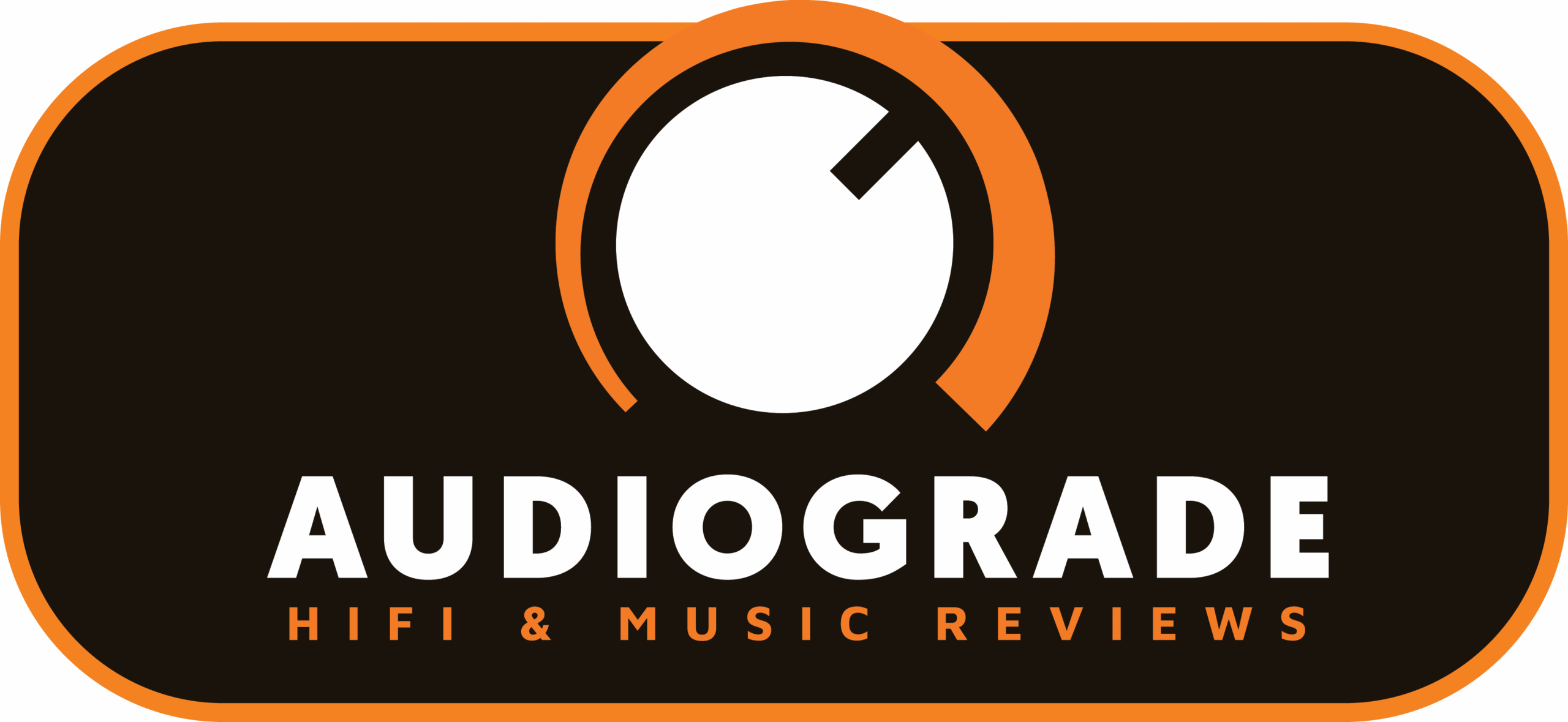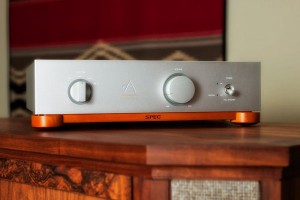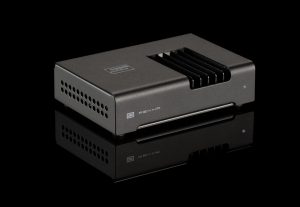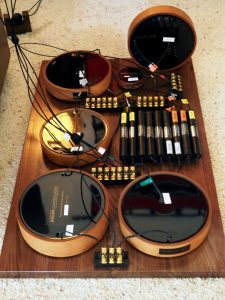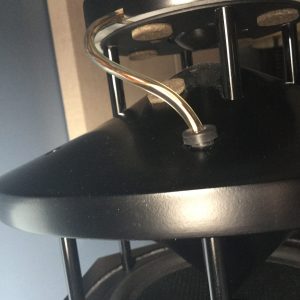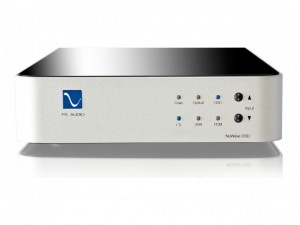.JPG)
It's hard to take eyes off new iFi products. This British company using logos, letters and design that all look like taken from Luxman, Leak, or Richard Allan products from 60ties or 70 ties, or from present production of Leben, entered a new (for them) niche part of a market usually called "vintage" (if you want to find out more about true "vintage" amplifiers you should read an article in Hi-Fi News & Record Reviews by R. Hindle, who offers valuable hints about which solid-state amps from 70ties are worth buying [December 2014, s. 130-134]).
British company named its new line (I believe it will include more than two products) iFi Retro, and the design is simply great, eye-catching, much better than the one of most authentic products from THAT time.
The integrated amplifier/DAC Stereo 50 and LS3.5 loudspeakers, that premiered recently are in fact something other than just a new version of "vintage" designs. Amplifier sports a wooden casing and tube output stage using EL84 power tubes plus ECF82 tubes in input stage and working as drivers. But its power supply differs from what we got used to as it is a switched mode PS.
If you take a look at this device from the top you might notice two things: a narrow gap across its width and an antenna sticking out from the back of the amplifier. Both are surely products of XXI century (at least in terms of popularity) and allow wireless connection via Bluetooth (also with AptX codec) with, for example, a tablet that can be placed in the above mentioned gap in a way they will allow user to see covers of the albums he listens to. Also any smartphone can be used to stream signal to Stereo 50.
Stereo 50 is about so much more than just wireless streaming of music. It is a hi-res D/A Converter accepting higher resolution files than any other DAC I know of. Most of currently manufactured DAC are not even capable of playing DXD files (32 bit/384kHz), or DSD256. What about iFi? Well, via (only) USB it accepts signal with the resolution of 2 x DXD, meaning up to 768kHz, but also DSD512 (24.6 MHz = Octo DSD). Have you seen any other device that could do that? I haven't. Sure, there are no recordings in these formats on the market and one can't even be sure if there will ever be any. Even if there will be some, their number will surely be very, very limited. But iFi proved, by designing a device with such a capabilities, that they simply were already able to do what others couldn't – they have "know" and "how".
.JPG)
Except for USB port the device sports also other digital input: coaxial and Toslink, but also a very nice phonostage. It will work with both, MM and MC cartridges. And it will produce a very nice sound with any of them. It sports adjustments and settings that will allow it to be a good match for almost any cartridge. One of the very interesting features is also a possibility of choosing a correction curve! There are very few phonostages, usually very expensive ones, that allow user to select a correction curve. One of them is Zanden 1200, reviewed some time ago by the "Hi-Fi Plus" magazine. In fact today quite a few people even know that there were different recording curves for stereo records used in the past, so it should be a good idea to explain this matter a bit.
Most vinyl fans believe that all the records were made using one standard RIAA (Recording Industry Association of America) curve. But in fact at the beginning of LP recording different labels used different curves. Some specialists name the following as the most important ones: Columbia, CCIR/Teldec, Decca, DMM and EMI. Such a classification is questioned nowadays by many other specialists. Some companies offer phonostages with adjustable, specialized curves that are supposed to be optimal for each of those standards. The former Hi-Fi+ Chief Editor, Roy Gregory, and few other prominent audio journalists are enthusiastic supporters of the idea of using different curves for different recordings.
One of the most known opponents is Michael Framer, Mr Analogue as some call him, or in other words one the most respected vinyl experts (see an interview with Michael HERE). He points out a lack of hard evidence proving that these labels actually used their own curves. He cites his conversations with technicians and engineers engaged in vinyl pressing process, working for those labels in 1950ties, who told him that the common RIAA standard was widely accepted and used already back then.
Whatever one's opinion on the subject, it is nice to be able to choose different curves for different records and to find out which one sounds best in every particular case. Does it remind you of something? Like 2 x DXD and Octo DSD playing capability—you have no idea how to use them but it makes you fell better knowing that you could use these features, right? It is really cool. What you will find really useful is a very serious headphone amplifier. ifi sports two headphone outputs: one for a large 6,3 mm jack, for low-sensitivity, high impedance cans, and one for a 3,75 mm mini jack, for portable headphones with low impedance. As for a "retro" device iFi Stereo 50 offers a lot of XXI century technologies which allows it to meet requirements of today's computers' users.
The LS3.5 loudspeakers refer directly, also with their name, to the "legendary legend" (that's a title I gave to my review of LS3.5a speakers, representatives of famous BBC family). Initially they were intended for monitoring recordings in BBC's mobile recording studios, but it didn't take long for music fans to realize that these speakers would do their job also in a home system, mainly because of the outstanding midrange reproduction. Many manufacturers, using a license from BBC built and sold (some do that still today) such speakers, including KEF, whose speakers I had a chance to review HERE. The iFi LS3.5 differ from those legendary speakers as iFi used different drivers, different cabinets, crossovers, binding posts, and obviously also their measurements are different. But the size and looks surely refer to BBC's loudspeakers.
.JPG)
TEST METHODOLOGY
An approach to the review of such a device with so many different functions had to differ from a "regular review". I had to evaluate Stereo 50 in few different configurations and places. To do so I used both HighFidelity's reference systems: System A and System B. In the former iFi worked with Harbeth M40.1 speakers and with two sources: Ancient Audio Lektor AIR V-edition CD Player and with Lumin S1. Signal was delivered to Stereo 50 via both, analogue and digital inputs, to evaluate separately a power amplifier and DAC. I also played some vinyls with Pro-Ject 1Xpression Carbon Classic.
In System B Stereo 50 worked with Graham Audio LS5/9 speakers, and Pro-Ject turntable as the main source. For assessment of headphone output I used: Sennheiser HD800, AKG K710, Audeze LCD-3 and HiFiMAN HE-6.
Part of the test was conducted with LS3.5. These are very small speakers that should be placed very close to the back wall. That's how they were placed for most of the time. To listen to the speakers without any colorization I moved them also to the middle of the room. A distance between listener's position and speakers was around 150cm—so that was a near-field listening. This way I managed to eliminate most of room's influence on the sound.
iFi AUDIO in High Fidelity
TEST: iFi Audio (Micro) iUSB POWER | iDAC | iCAN – USB power supply + headphone amplifier+ D/A Converter USB , see HERE
.JPG)
SOUND
Recordings used for this test (a selection)
• Marek Sierocki presents: I Love 80s, Sony Music 8725464752, 4 x CD (2012).
• Aretha Franklin, I Never Loved a Man the Way I Love You, Atlantic Record, DSF (1967/2014).
• Billie Holliday, Body And Soul, Verve Records, DSF, (1957/2013).
• Fleetwood Mac, Rumours, Rhino, FLAC 24/96.
• Frank Sinatra, The Voice, Columbia/Classic RecordsCL 743, Quiex SV-P, "50th Anniversary", 180g LP (1955/2005).
• Freddie Hubbard, Open Sesame, Blue Note/Classic Records BT4040, Quiex SV-P, 200 g LP (1960/1999).
• Hans Theesink, Live at Jazzland, Sommelier Du Son sds 0016-1, 180 g LP (2014).
• Kitty, Daisy & Lewis, Kitty, Daisy & Lewis, Sunday Best SBEST25, 180 g LP (2008).
• Led Zeppelin, Led Zeppelin (I), Atlantic/Warner Music, WAV 24/96 (1961/2014).
• Leonard Cohen, Popular Problems, Sony Music Labels SICP-4329, CD (2014); review HERE.
• Nat "King" Cole, Love is the Thing, Capitol, DSF (1957/2012).
• Savage, Tonight, Extravaganza Publishing/Klub80 Records CD001, "25th Anniversary Limited Edition No59/150", CD (1984/2009); review HERE.
• Stan Getz/Joao Gilberto, Getz/Gilberto, Verve/HDTracks, 24/96 FLAC (1964/2009).
• Urszula, Wielki odlot 2. Najlepsze 80-te, Universal Music Polska 378 577 4, CD (2014).
When a true audiophile company that in a process of creating new devices combines solid engineering with listening sessions done by engineers who also happen to be audiophiles and music fans themselves, releases a new product that is so different from anything they've done so far, a question arises—who is this new product designed for?
A well managed company with concrete future plans for development wouldn't suddenly experiment with something totally different just to check out if it could work. There is no place for this kind of "maybes" in a real world. If there were, one should be seriously worried about the future of such a venture.
An information about Stereo 50, that I had received right before Munich High End Show 2014 was of that kind that makes one scratch one's head wondering: "what the hell had these guy being thinking?!". After I had a chance to see it with my own eyes first in Munich and then in Warsaw and talk to iFi's Vincent Luke, despite the fact that I didn't actually get any concrete explanations to my doubts about this product, I started to think that maybe iFi guys were not that "crazy". First answers really came only after I had a chance to unpack Stereo 50 at home, listen to it and play with it. I realized that it was a system for music fans and audiophiles, not those extreme ones, but those who like to have fun with their audio "toys". That is also a product that we, audiophiles, could recommend to our friends, wives, kids, families, neighbors and anybody who seeks an advice from an "expert".
"Fun" is a key word here. Using Stereo 50 is a great fun as it is a complete system designed by true professionals, who really know what they're doing. But I suspect that these "serious" guys are also, at least partially, somewhere deep inside, kids who appreciate a simplicity of usage, "looks", and a connectivity that allows them to use almost any sound source they might think of, and all that at very reasonable price. Stereo 50 gives you all that, and it sounds damn good!
As with any multi-functional device also this time I had to take a multidimensional approach to this review—more about it you can find in "test methodology" section. I think that most customers will buy this setup to use this amplifier with speakers, delivering digital signal to the DAC, probably mostly via USB from a computer. If that's the case I have a good news for you—it so happens that USB input offers the best performance, plus it is also the most versatile input.
.JPG)
STEREO 50
This British rig offers a very pleasant, amazingly smooth sound. I think that most of the credit for this sound characteristic goes to the DAC. I don't mean that DAC has to "correct" the sound of amplifier. No, it doesn't, which I checked using also CD Player and Lumin S1 as sources of analogue signal. These delivered more open sound but still dominant sound features were: smoothness, liquidity and richness.
It is possible to hear this "richness" of the sound only when one puts speakers on a large, flat surface (on a desk, or on commode) close to a back wall. The LS 3.5 speakers are able to deliver such a good quality bass, at least its middle and upper part, that even placed on stands in the middle of the room they don't sound "lean" or "slim". Well, I gave them some support by using "Xbass" switch, but that's what it was for, right? Same as "Bass Boost" switch in Leben, that I also like to use when listening via headphones. If it is there, why not to use it?
For this particular test I used a lot of recordings that we like to listen to, but don't like to brag about it (apologies to those who don't listen to "such" music). What kind of recordings? Well a lot from 1980ties, like remastered Savage's Tonight, like Urszula, Bajm (I attended their concert recently), in short—a lot of recordings that don't sound like audiophile SHM-CDs.
And a sound these hardly compressed, bright (except for Savage), harsh sounding recordings was, to our surprise quite pleasant. DAC did a good job of smoothing them, rolling slightly the treble off, but just slightly, enough to make them sound in a pleasant way and not to damp treble completely. The result was quite vivid, palpable, large scale sound, also quite dynamic one, pleasant to listen to.
It turned out that this amplifier was able to drive also large speakers in a way, that nobody sane would think was possible. If that had been just a tube amplifier for 5.000 PLN it would have been a very attractive proposal, one of the best in its price range. But it is not just an amplifier. It sports a good sounding D/A Converter with multiple inputs, DSD and hi-res capabilities. When you think about it, it seems that you get this DAC as a free bonus. But that's not the only one. There is also a very nice phonostage at your disposal. And headphone amplifier, too. Well, it is obviously not true that you get them for free—iFi surely wouldn't give away anything for free, because, as every company, they also have to make money of their products. But considering how good the amplifier is one might have an impression that all other elements one gets for free.
.JPG)
I have no idea whether Leben CS300 was any sort of inspiration for Stereo 50 designers, but the truth is that both sound really good with Sennheiser HD800. ifi sounded also very nice with AKG K701. With these cans I noticed some similar qualities of the sound that I'd noticed with mighty Harbeth M40.1 driven by Stereo 50 before: richness and smoothness. But this setup wasn't that resolving nor selective. And the focus was surely on everything that was happening in the front of the soundstage and not in the back.
This latter quality is usually considered by audiophiles as a deviation from neutrality. But, as we've already established, this is a device for audiophiles but also for many different people audiophiles are surrounded with. So what we should understand is that most of these devices will work in far from optimal conditions, and thus such a close to a listener presentation should be more appreciated than a deep soundstage but at the expense of richness of the sound's tonality. And still apart from a really good DAC, and a very, very nice headphone amp, Stereo 50 is able to deliver also a rich, smooth and balanced sound from a vinyl record.
I listened to few records played with Pro-Ject 1Xpression Carbon with Ortofon M2 Silver cartridge. This time there was this depth of the sound that is usually attributed to vinyl records. Presentation was also nicely balanced and colorful. Dynamics wasn't its particular strength, at least on micro level, which was one of the similarities to DAC's presentation. On macro level dynamics was quite impressive like on Hans Theessink's Live at Jazzland (it was a copy signed by the artist after his performance at Audio Show 2014 for our translator, Andrzej Dziadowiec so it had to sound really good!
Now I could just move to the next part of this review but there is one more thing I need to write about before I do that: bass. The EL84 power tubes used in this design are small penthodes designed originally by Philips for audio purposes. It's surely not as popular and respected like its larger cousin EL34 or beam tetrodes like KT66 and KT88, but in good hands it can deliver an outstanding performance.
A quality of bass range delivered by amplifier/DAC Stereo 50 is extraordinary comparing to any other tube or solid-state amps. Bass is rich, punchy and punctual. It seems to control and drive the whole presentation. It is not particularly selective, the envelope of bass guitar and bass drum notes is not as distinct, as clear as presented by the best solid state amps at this price range, but iFi doesn't fall far behind either. And it makes up for it when it comes to tonality, tunefulness. These elements contribute to the final effect which is very attractive to listen to.
SYSTEM
In this configuration proposed by iFi, with LS 3.5 speakers I mean, Stereo 50 delivers a very good performance. But between these two products it is the amplifier/DAC that has more potential. Speakers offer fast, open sound, while amplifier/DAC delivers more "creamy", warmer one. These two "halfs" complete each other creating a very nice sounding rig together.
And yet, it is possible to get even better performance from this amplifier/DAC by replacing speakers. I would suggest listening to it with Harbeth, Spendor, and above all with Sonus faber like, for example, Minima Vintage, or a model from Olimpia line speakers.
You can use any source you like. An inexpensive turntable like Pro-Ject I used, seems a very reasonable choice.
A choice of digital source is more up to a particular user of Stereo 50. I usually don't use any compressed files, but to my surprise I had a real fun listening to the music played via Bluetooth. A party with this rig must be a real fun!
Still, if one expects a really good sonic results one has do deliver iFi a good quality digital signal. Many users will surely use their computers, as it is the least expensive solution. And that's a good solution—this way you can play DSD and DXD files, too. Another solution is to buy an inexpensive files player and connect it to a coaxial input of Stereo 50.
But if you REALLY want to hear what iFi is capable of in terms of sound quality you need a high quality CD Player. Today, in times of many "ultimate" music formats, you might think of CD as an anachronistic, or obsolete medium, but for me it is a CD that still offers the highest sound quality. In my opinion even the best files players playing files with sampling frequencies of millions of bits are not able to deliver such a highest quality performance as the best CD Players. Files surely have apotential, that probably will be utilized some day. But today I have most pleasure, most fun listening to the music from a CD (and vinyl). So what I would recommend for you is to get a nice CD Transport like Heed Audio DT, Pro-Ject CD Box RS, or one of Cyrus products. It will be a very nice addition to this wonderful rig and together they will deliver a heartful performance with any kind of music.
Summary
The system under review was like a meteor that entered Earth's atmosphere with a loud boom and filled the sky with light. You should really give it a listen. Yes, with separate iFi products you might get a better performance in terms of dynamics and resolution, but it will take a lot more effort, money, and additional costs for proper cables. And you won't be able to enjoy this original Stereo 50's looks. I can fully understand those, who value sound quality above all and will buy separate iFi devices—but I wouldn't do it.
This system does a good job in everything it does. Both, together with LS3.5, and as a separate amplifier/DAC iFi provides its user with a lot of fun and joy. Whatever you think you need from your system—iFi's got it.
DESIGN
This iFi system is usually presented on photos as a whole, but in fact one can buy Stereo 50 and speakers separately. That's why they also have their own names and are packed separately inside very nice, "lifestyle" boxes.
Stereo 50
It is an integrated amplifier with MM/MC phonostage, D/A Converter that also with Apt-X Bluetooth input and a headphone amplifier. All that in one Bamboo box. There is probably no other manufacturer who'd be prepared to create a device like that. ifi could do it thanks to its experience with Micro line.
Despite its huge functionality Stereo 50 looks, at least at first look, like a tube amplifier from 1950ties, or 1960ties. It is the wood-like casing and a front panel that makes us think that.
The casing is in fact made of Bamboo plates. Despite the fact that this plant belong to grass family it looks more like a tree. Bamboo has a higher compressive strength than wood and is more resilient to fluctuations of humidity levels. And it looks simply great! There are some elongated slots on the side panels and another on top panel (covered with a grid) to improve heat transfer thus keeping tubes and electronic circuit at reasonable temperatures.
.jpg)
Front
Front panel is made of aluminum. A color was chosen on purpose to make iFi look like old Luxman and Marantz devices. Another company that uses today the same idea is Leben. ifi's gold color reminded me more of actual old gold than the color used by Leben or Accuphase.
Front sports also four middle-size knobs and a whole row of toggle switches. Two on the left can be used to adjust tone, or to set a curve for phono input. This first function is self-explanatory. There is a switch that allows user to turn this adjustment off.
The knobs on the right allow user to choose an active input and to control volume. There are two analogue, linear inputs, one of them with dual function with RCA sockets on the back and mini-jack input on the front. There are also two phono inputs—for MM and high level MC, and for low level MC cartridges. A small switch allows user to choose gain for MM/MC input (38dB/50 dB), or to switch this input into linear mode with +6dB gain.
On a front panel there are two headphone inputs: one for large jack, for classic high impedance cans, another for mini-jack suitable for portable headphones of low impedance and high efficiency.
As I've mentioned above one of the switches allows user to turn tone control off. Those who had a chance to play with iFi iCAN should recognize the next two: "XBass" (with 3 settings: two of them enhance bass, the third is called "Direct" and means no enhancement at all) and 3D HolographicSound (also three settings—two enhancing spacing, one playing it "Direct").
The last switch allows user to choose an active digital input. There are four of them: USB, coax RCA, optical mini-Toslink and Bluetooth. The latter offers high quality performance due to usage of AptX codec.
When user chooses particular input the magic begins with small backlit writings and a multicolor triangle LED coming alive on a front panel. Small writings, or logos inform us of a type of signal delivered to DAC: DXD, DSD or PCM. A color of the LED tells us about active input and sampling frequency of the signal delivered. There are a lot of colors but don't worry together with the device comes a detailed description with a drawing that explains meaning of each color.
.jpg)
Back
This device combines functions of an integrated amplifier and a DAC in one box. Despite that iFi's engineers managed to design a back panel in a way that it doesn't look "overcrowded". There are two pairs of gold-plated speakers posts. At the time of the review no description of the device was available so I can't tell you for which speaker impedance this amplifier was optimized for. What I do know is the rated output power of Stereo 50 is 25W per channel. Below there are two rows of RCA sockets for linear and phono inputs and also digital inputs.
The asynchronous USB input is the most amazing among digital inputs. ifi's engineers achieved something that none other did—USB port accepts PCM signal up 24/192 and DXD up to 768kHz! As for DSD it will accept even DSD512 (24.6 MHz), which is called Octo DSD!!! Yes, I do realize that I got excited about something with no practical use today, as there are no such recordings, and to be honest we can't be sure there ever will be. But iFi users can easily wait for the future to come—whatever happens they will be ready. The coaxial and optic inputs accept signal up to 24-bits and 192kHz. Above those there is a socket for a Bluetooth antenna.
.jpg)
Inside
When you take off this very nice bamboo enclosure you will realize that the actual casing is hidden underneath. It is a rigid frame made of steel bars that shields the digital section of the device. This section together with a switched mode power supply are additionally shielded with a metal sheet. To get under it I would have to completely disassemble the whole device—I gave up.
I could see an amplifier section though. It is based on tubes: miniature triode-pentode ECF82 working in the input section, as phase inverters and as drivers, and EL84X power tubes in the output section. The latter work in AB class, push-pull mode. Tubes bear an iFi "Premium Sound" logos—the selection and matching is done in-house. The ceramic tube sockets sport gold plated pins.
.jpg)
A tone adjustment is conducted via miniature pots, and a black motorized Alps is used for volume control. Volume can be also controlled with a small remote that sports just two small buttons. Manufacturer decided to use also high quality passive elements like Wima coupling capacitors and had a good idea how to connect a pot with the rest of the circuit. Usually this connection is made with poor quality shielded cables. iFi uses a much better solution: signal goes with high quality cables, same as are used for real time transmissions, and they use the same sort of cable to connect Bluetooth's antenna with a receiver. Cables are plugged to PCBs with professional, gold plated plugs.
LS3.5
The LS3.5 loudspeakers seem a simpler design than Stereo 50 amplifier, but in fact I think that they are even more interesting. Their cabinets are made of bamboo. The side walls are thinner than top and bottom because these speakers are tuned in way that some instruments, like guitar, are. There are some additional elements fixed inside to tune resonance frequency. It is possible that iFi's designers took this idea from Japanese Kiso Acoustics HB-X1 speakers. On their web site you can watch a film showing how it is done. This manufacturer mentions designs of P.G.A.H. Voight. This inventor and designer is known, among other things, of developing a horn called Tractrix ( in 1926).
.jpg)
On the back wall there is a horizontal gap—that's an vent of an acoustic loading of the mid- lowrange driver, that includes a small labyrinth with two chambers. Above that gap there is a single pair of gold plated, copper binding posts. LS 3.5 sports two drivers: a 25 mm tweeter with silk dome, and a 110 mm mid- lowrange woofer with a paper, coated diaphragm. It uses a metal basket and large magnet. Tweeter uses a small neodymium magnet. Both drivers are marked with iFi's logo.
.jpg)
Inside of cabinet is damped with special advanced amino-plastic open cell acoustic foam. There are small cubic pieces of that foam placed in the upper and lower chamber and there is nothing else in there.
Drivers are connected with multistrand silver plated copper wires. A crossover is absolutely minimalist—there is only a single polypropylene capacitor soldered directly to the tweeter.
The design of LS3.5 is quite extraordinary and so is their performance. On one hand it is quite a simple design using some solutions that's been known for many years, but on the other it is somehow appealing to the best part of my technical education.
Price (during review, in Poland):
5.990 + 4.390 PLN
Abbingdon Global Group
http://www.amr-audio.co.uk
22 Notting Hill Gate | London
W11 3JE | United Kingdom
[email protected]
www.ifi-audio.com
Country of origin: UNITED KINGDOM
Images by BŁ/Piksel Studio







